Assessment Questions for Depression Disorder in Geriatric Patients
VerifiedAdded on 2022/09/11
|7
|1433
|20
Report
AI Summary
This report delves into the complexities of depression disorder, specifically focusing on its impact on the geriatric population. It outlines the diagnostic criteria outlined in DSM-5, emphasizing the importance of recognizing symptoms such as persistent sadness, loss of interest, and physical manifestations like chronic pain. The report highlights the use of assessment questions tailored for the elderly, considering factors such as marital status, family support, and overall life satisfaction. The assessment questions are designed to identify key indicators of depression, including changes in activity levels, emotional states, and suicidal ideation. The paper also stresses the significance of family involvement in the care of depressed elderly individuals and the need for early intervention, including marriage counseling, to address underlying issues. Furthermore, the report explores the evolution of DSM-5 criteria, including the consideration of anxious distress and manic symptoms in diagnosing depression.
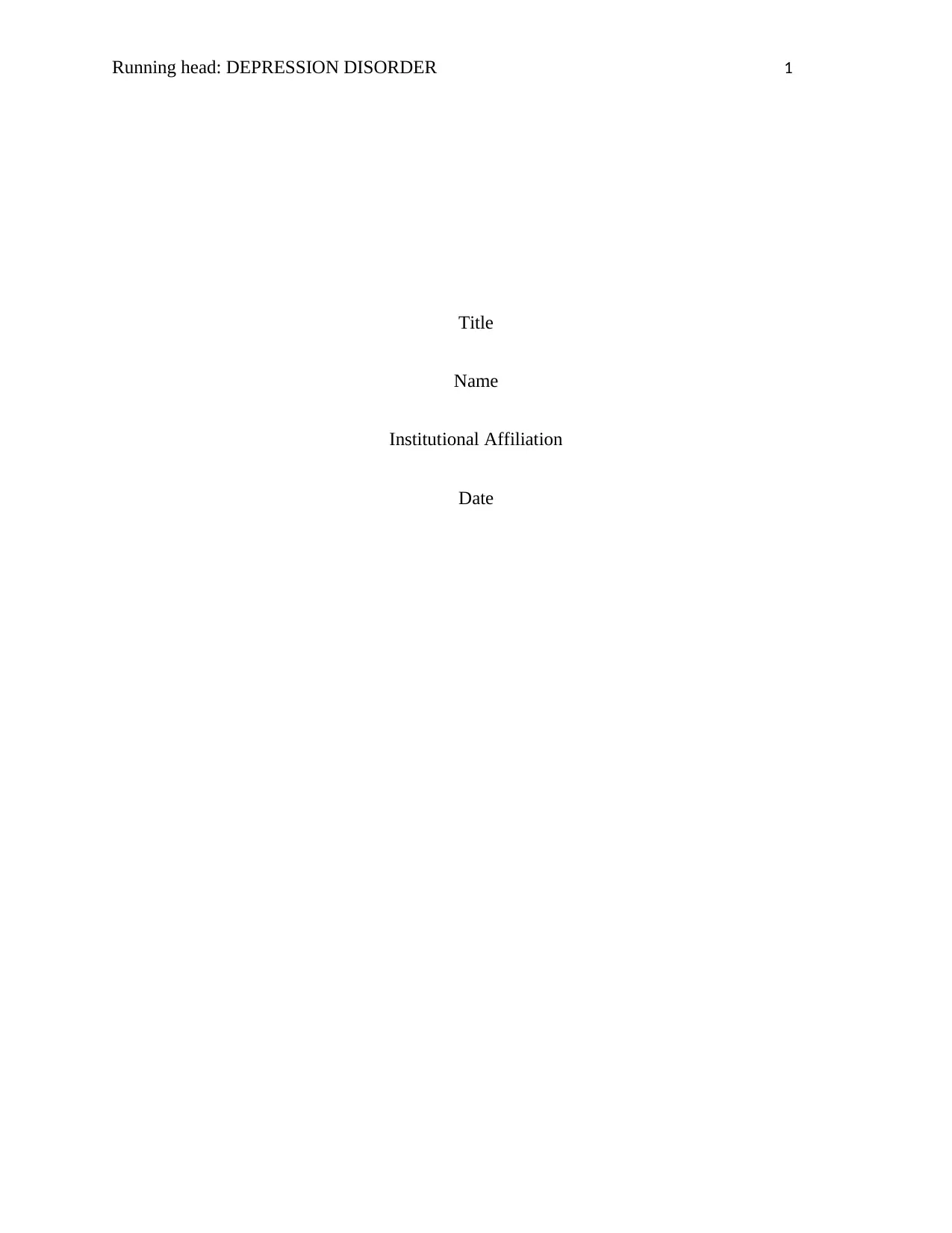
Running head: DEPRESSION DISORDER 1
Title
Name
Institutional Affiliation
Date
Title
Name
Institutional Affiliation
Date
Paraphrase This Document
Need a fresh take? Get an instant paraphrase of this document with our AI Paraphraser
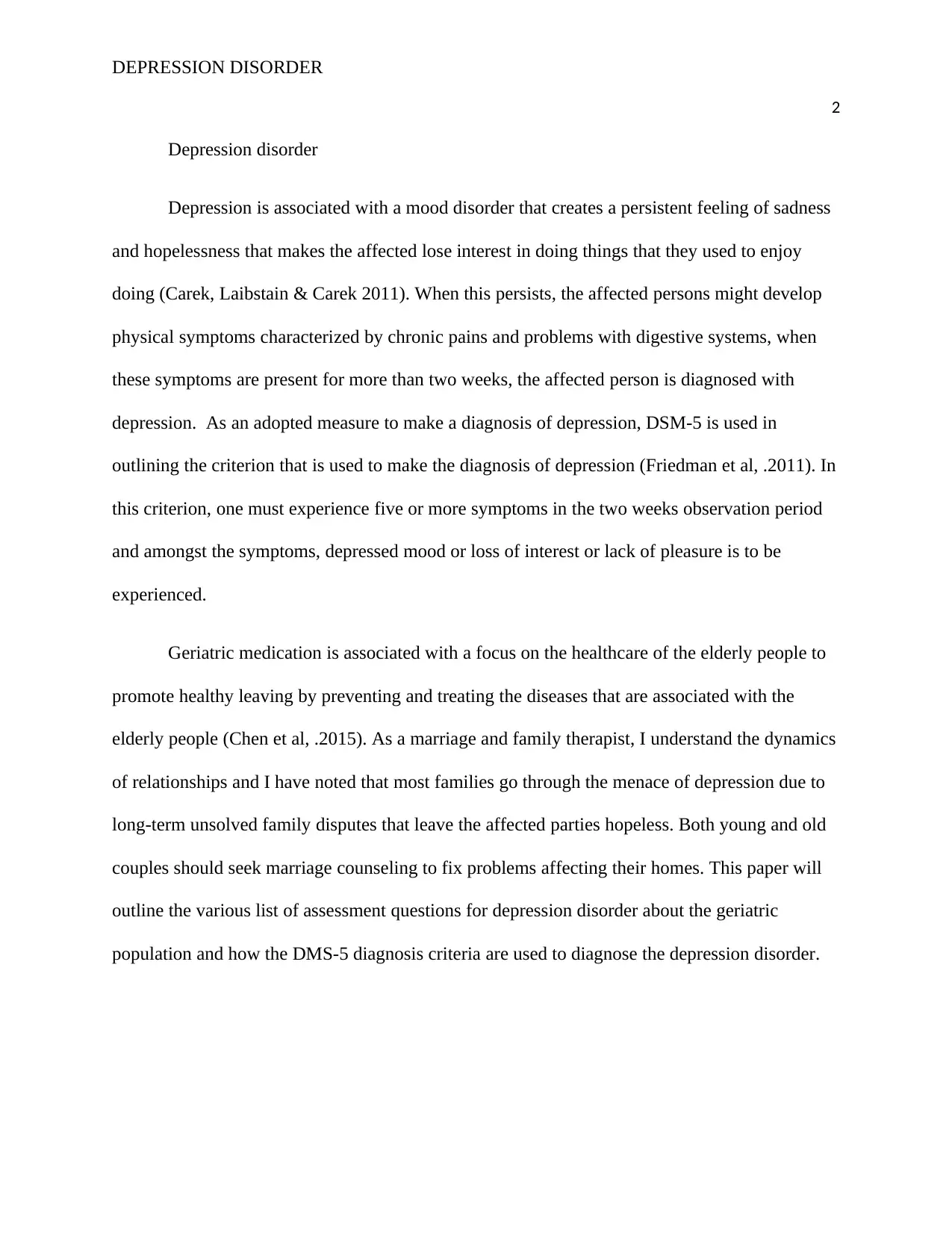
DEPRESSION DISORDER
2
Depression disorder
Depression is associated with a mood disorder that creates a persistent feeling of sadness
and hopelessness that makes the affected lose interest in doing things that they used to enjoy
doing (Carek, Laibstain & Carek 2011). When this persists, the affected persons might develop
physical symptoms characterized by chronic pains and problems with digestive systems, when
these symptoms are present for more than two weeks, the affected person is diagnosed with
depression. As an adopted measure to make a diagnosis of depression, DSM-5 is used in
outlining the criterion that is used to make the diagnosis of depression (Friedman et al, .2011). In
this criterion, one must experience five or more symptoms in the two weeks observation period
and amongst the symptoms, depressed mood or loss of interest or lack of pleasure is to be
experienced.
Geriatric medication is associated with a focus on the healthcare of the elderly people to
promote healthy leaving by preventing and treating the diseases that are associated with the
elderly people (Chen et al, .2015). As a marriage and family therapist, I understand the dynamics
of relationships and I have noted that most families go through the menace of depression due to
long-term unsolved family disputes that leave the affected parties hopeless. Both young and old
couples should seek marriage counseling to fix problems affecting their homes. This paper will
outline the various list of assessment questions for depression disorder about the geriatric
population and how the DMS-5 diagnosis criteria are used to diagnose the depression disorder.
2
Depression disorder
Depression is associated with a mood disorder that creates a persistent feeling of sadness
and hopelessness that makes the affected lose interest in doing things that they used to enjoy
doing (Carek, Laibstain & Carek 2011). When this persists, the affected persons might develop
physical symptoms characterized by chronic pains and problems with digestive systems, when
these symptoms are present for more than two weeks, the affected person is diagnosed with
depression. As an adopted measure to make a diagnosis of depression, DSM-5 is used in
outlining the criterion that is used to make the diagnosis of depression (Friedman et al, .2011). In
this criterion, one must experience five or more symptoms in the two weeks observation period
and amongst the symptoms, depressed mood or loss of interest or lack of pleasure is to be
experienced.
Geriatric medication is associated with a focus on the healthcare of the elderly people to
promote healthy leaving by preventing and treating the diseases that are associated with the
elderly people (Chen et al, .2015). As a marriage and family therapist, I understand the dynamics
of relationships and I have noted that most families go through the menace of depression due to
long-term unsolved family disputes that leave the affected parties hopeless. Both young and old
couples should seek marriage counseling to fix problems affecting their homes. This paper will
outline the various list of assessment questions for depression disorder about the geriatric
population and how the DMS-5 diagnosis criteria are used to diagnose the depression disorder.
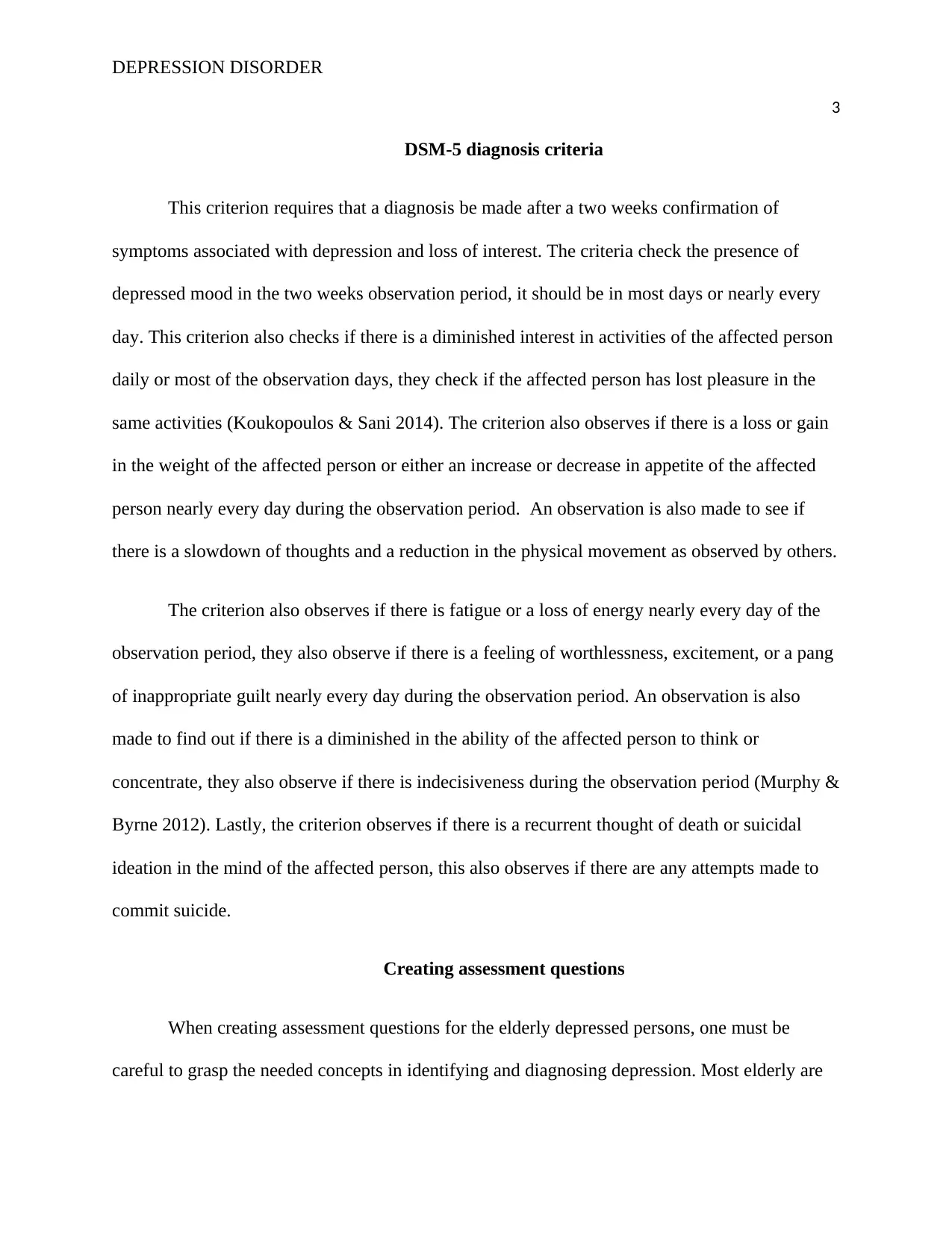
DEPRESSION DISORDER
3
DSM-5 diagnosis criteria
This criterion requires that a diagnosis be made after a two weeks confirmation of
symptoms associated with depression and loss of interest. The criteria check the presence of
depressed mood in the two weeks observation period, it should be in most days or nearly every
day. This criterion also checks if there is a diminished interest in activities of the affected person
daily or most of the observation days, they check if the affected person has lost pleasure in the
same activities (Koukopoulos & Sani 2014). The criterion also observes if there is a loss or gain
in the weight of the affected person or either an increase or decrease in appetite of the affected
person nearly every day during the observation period. An observation is also made to see if
there is a slowdown of thoughts and a reduction in the physical movement as observed by others.
The criterion also observes if there is fatigue or a loss of energy nearly every day of the
observation period, they also observe if there is a feeling of worthlessness, excitement, or a pang
of inappropriate guilt nearly every day during the observation period. An observation is also
made to find out if there is a diminished in the ability of the affected person to think or
concentrate, they also observe if there is indecisiveness during the observation period (Murphy &
Byrne 2012). Lastly, the criterion observes if there is a recurrent thought of death or suicidal
ideation in the mind of the affected person, this also observes if there are any attempts made to
commit suicide.
Creating assessment questions
When creating assessment questions for the elderly depressed persons, one must be
careful to grasp the needed concepts in identifying and diagnosing depression. Most elderly are
3
DSM-5 diagnosis criteria
This criterion requires that a diagnosis be made after a two weeks confirmation of
symptoms associated with depression and loss of interest. The criteria check the presence of
depressed mood in the two weeks observation period, it should be in most days or nearly every
day. This criterion also checks if there is a diminished interest in activities of the affected person
daily or most of the observation days, they check if the affected person has lost pleasure in the
same activities (Koukopoulos & Sani 2014). The criterion also observes if there is a loss or gain
in the weight of the affected person or either an increase or decrease in appetite of the affected
person nearly every day during the observation period. An observation is also made to see if
there is a slowdown of thoughts and a reduction in the physical movement as observed by others.
The criterion also observes if there is fatigue or a loss of energy nearly every day of the
observation period, they also observe if there is a feeling of worthlessness, excitement, or a pang
of inappropriate guilt nearly every day during the observation period. An observation is also
made to find out if there is a diminished in the ability of the affected person to think or
concentrate, they also observe if there is indecisiveness during the observation period (Murphy &
Byrne 2012). Lastly, the criterion observes if there is a recurrent thought of death or suicidal
ideation in the mind of the affected person, this also observes if there are any attempts made to
commit suicide.
Creating assessment questions
When creating assessment questions for the elderly depressed persons, one must be
careful to grasp the needed concepts in identifying and diagnosing depression. Most elderly are
⊘ This is a preview!⊘
Do you want full access?
Subscribe today to unlock all pages.

Trusted by 1+ million students worldwide
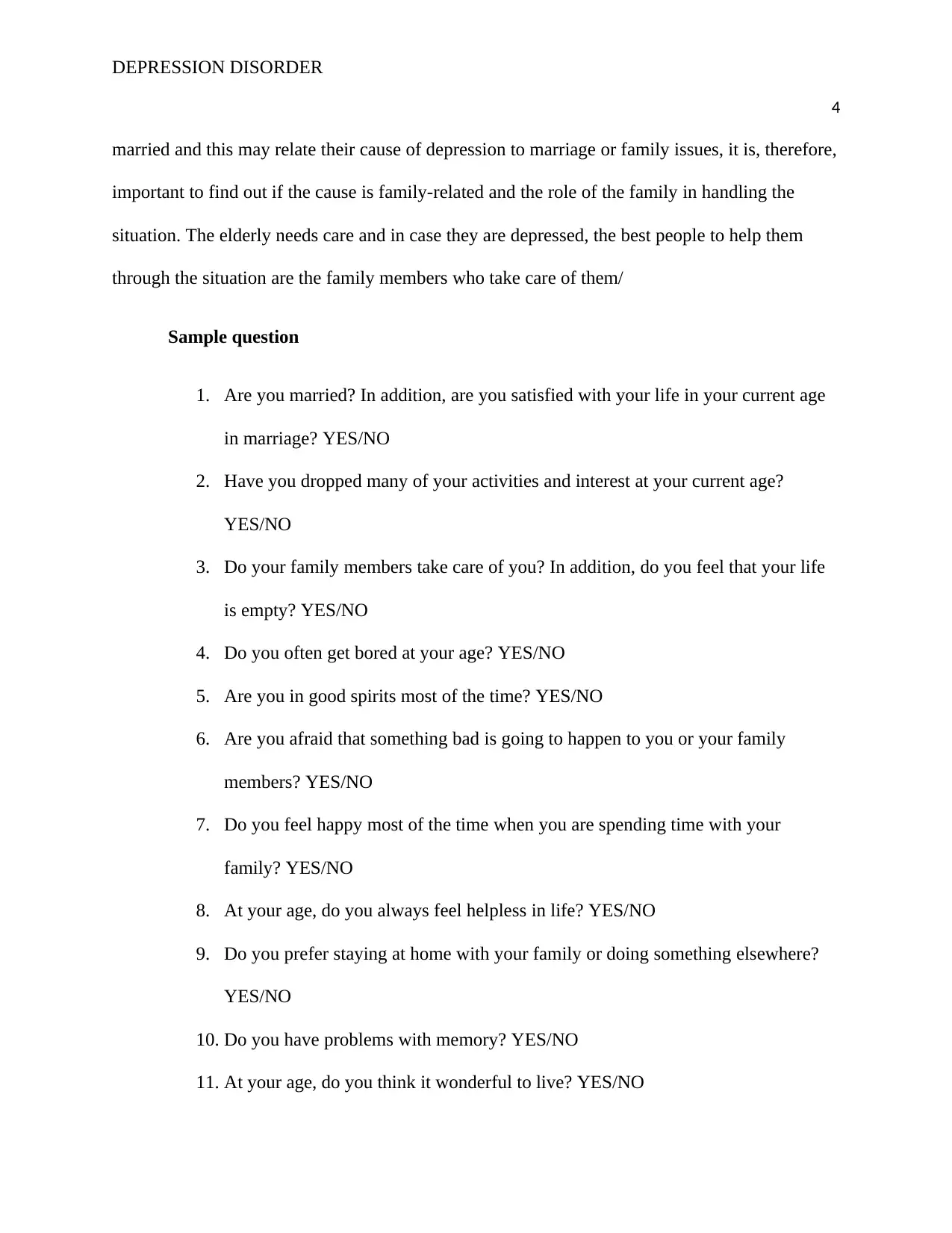
DEPRESSION DISORDER
4
married and this may relate their cause of depression to marriage or family issues, it is, therefore,
important to find out if the cause is family-related and the role of the family in handling the
situation. The elderly needs care and in case they are depressed, the best people to help them
through the situation are the family members who take care of them/
Sample question
1. Are you married? In addition, are you satisfied with your life in your current age
in marriage? YES/NO
2. Have you dropped many of your activities and interest at your current age?
YES/NO
3. Do your family members take care of you? In addition, do you feel that your life
is empty? YES/NO
4. Do you often get bored at your age? YES/NO
5. Are you in good spirits most of the time? YES/NO
6. Are you afraid that something bad is going to happen to you or your family
members? YES/NO
7. Do you feel happy most of the time when you are spending time with your
family? YES/NO
8. At your age, do you always feel helpless in life? YES/NO
9. Do you prefer staying at home with your family or doing something elsewhere?
YES/NO
10. Do you have problems with memory? YES/NO
11. At your age, do you think it wonderful to live? YES/NO
4
married and this may relate their cause of depression to marriage or family issues, it is, therefore,
important to find out if the cause is family-related and the role of the family in handling the
situation. The elderly needs care and in case they are depressed, the best people to help them
through the situation are the family members who take care of them/
Sample question
1. Are you married? In addition, are you satisfied with your life in your current age
in marriage? YES/NO
2. Have you dropped many of your activities and interest at your current age?
YES/NO
3. Do your family members take care of you? In addition, do you feel that your life
is empty? YES/NO
4. Do you often get bored at your age? YES/NO
5. Are you in good spirits most of the time? YES/NO
6. Are you afraid that something bad is going to happen to you or your family
members? YES/NO
7. Do you feel happy most of the time when you are spending time with your
family? YES/NO
8. At your age, do you always feel helpless in life? YES/NO
9. Do you prefer staying at home with your family or doing something elsewhere?
YES/NO
10. Do you have problems with memory? YES/NO
11. At your age, do you think it wonderful to live? YES/NO
Paraphrase This Document
Need a fresh take? Get an instant paraphrase of this document with our AI Paraphraser
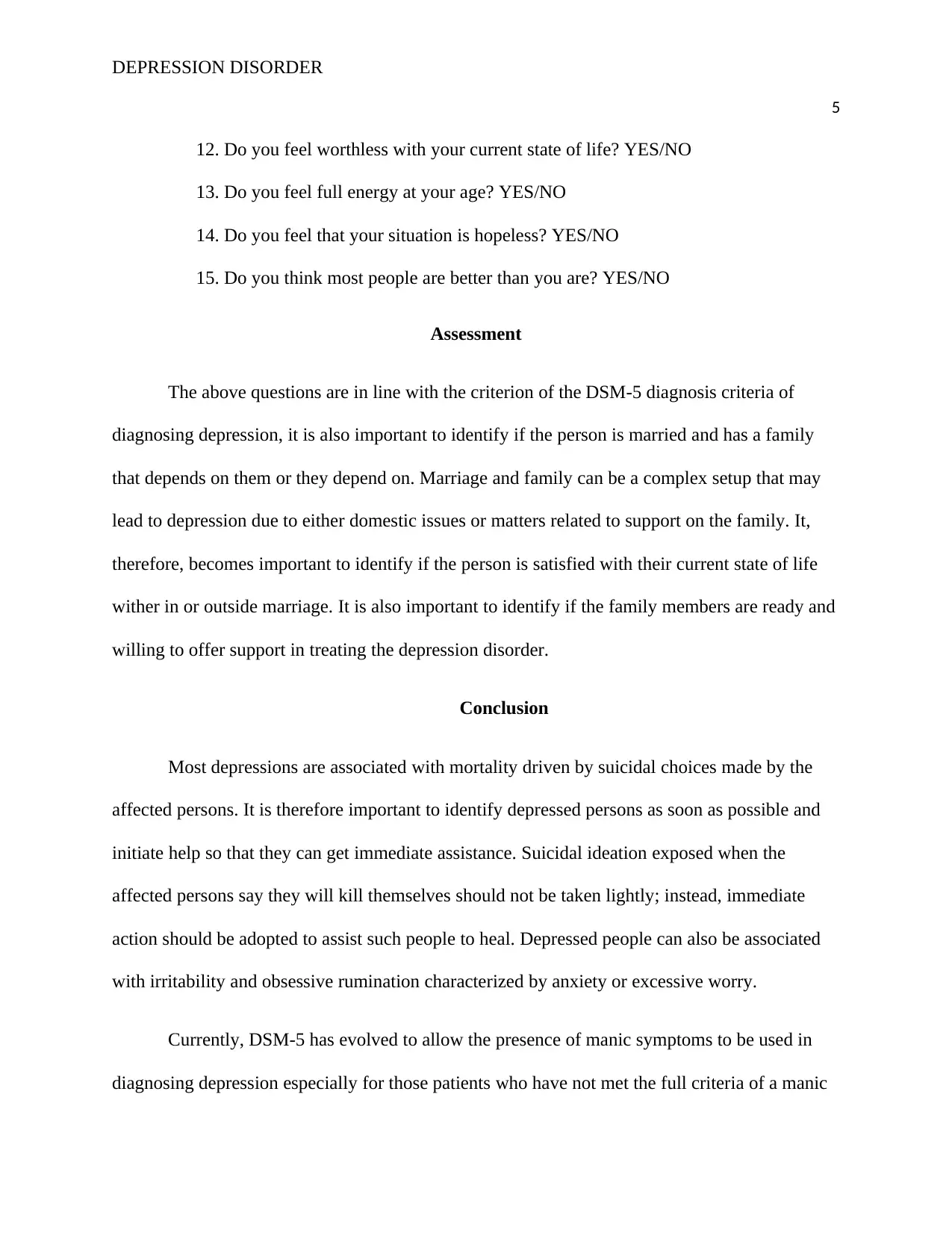
DEPRESSION DISORDER
5
12. Do you feel worthless with your current state of life? YES/NO
13. Do you feel full energy at your age? YES/NO
14. Do you feel that your situation is hopeless? YES/NO
15. Do you think most people are better than you are? YES/NO
Assessment
The above questions are in line with the criterion of the DSM-5 diagnosis criteria of
diagnosing depression, it is also important to identify if the person is married and has a family
that depends on them or they depend on. Marriage and family can be a complex setup that may
lead to depression due to either domestic issues or matters related to support on the family. It,
therefore, becomes important to identify if the person is satisfied with their current state of life
wither in or outside marriage. It is also important to identify if the family members are ready and
willing to offer support in treating the depression disorder.
Conclusion
Most depressions are associated with mortality driven by suicidal choices made by the
affected persons. It is therefore important to identify depressed persons as soon as possible and
initiate help so that they can get immediate assistance. Suicidal ideation exposed when the
affected persons say they will kill themselves should not be taken lightly; instead, immediate
action should be adopted to assist such people to heal. Depressed people can also be associated
with irritability and obsessive rumination characterized by anxiety or excessive worry.
Currently, DSM-5 has evolved to allow the presence of manic symptoms to be used in
diagnosing depression especially for those patients who have not met the full criteria of a manic
5
12. Do you feel worthless with your current state of life? YES/NO
13. Do you feel full energy at your age? YES/NO
14. Do you feel that your situation is hopeless? YES/NO
15. Do you think most people are better than you are? YES/NO
Assessment
The above questions are in line with the criterion of the DSM-5 diagnosis criteria of
diagnosing depression, it is also important to identify if the person is married and has a family
that depends on them or they depend on. Marriage and family can be a complex setup that may
lead to depression due to either domestic issues or matters related to support on the family. It,
therefore, becomes important to identify if the person is satisfied with their current state of life
wither in or outside marriage. It is also important to identify if the family members are ready and
willing to offer support in treating the depression disorder.
Conclusion
Most depressions are associated with mortality driven by suicidal choices made by the
affected persons. It is therefore important to identify depressed persons as soon as possible and
initiate help so that they can get immediate assistance. Suicidal ideation exposed when the
affected persons say they will kill themselves should not be taken lightly; instead, immediate
action should be adopted to assist such people to heal. Depressed people can also be associated
with irritability and obsessive rumination characterized by anxiety or excessive worry.
Currently, DSM-5 has evolved to allow the presence of manic symptoms to be used in
diagnosing depression especially for those patients who have not met the full criteria of a manic
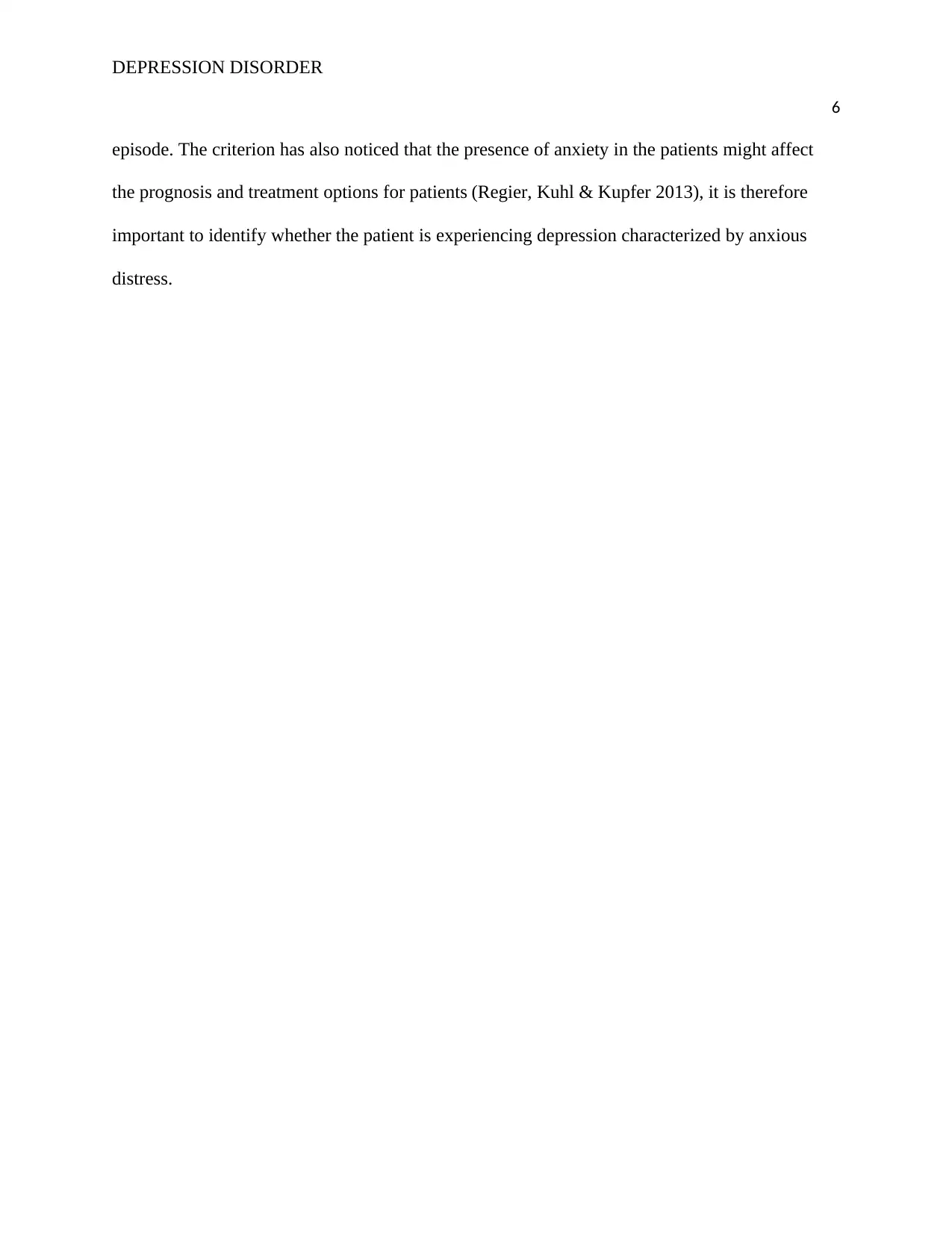
DEPRESSION DISORDER
6
episode. The criterion has also noticed that the presence of anxiety in the patients might affect
the prognosis and treatment options for patients (Regier, Kuhl & Kupfer 2013), it is therefore
important to identify whether the patient is experiencing depression characterized by anxious
distress.
6
episode. The criterion has also noticed that the presence of anxiety in the patients might affect
the prognosis and treatment options for patients (Regier, Kuhl & Kupfer 2013), it is therefore
important to identify whether the patient is experiencing depression characterized by anxious
distress.
⊘ This is a preview!⊘
Do you want full access?
Subscribe today to unlock all pages.

Trusted by 1+ million students worldwide
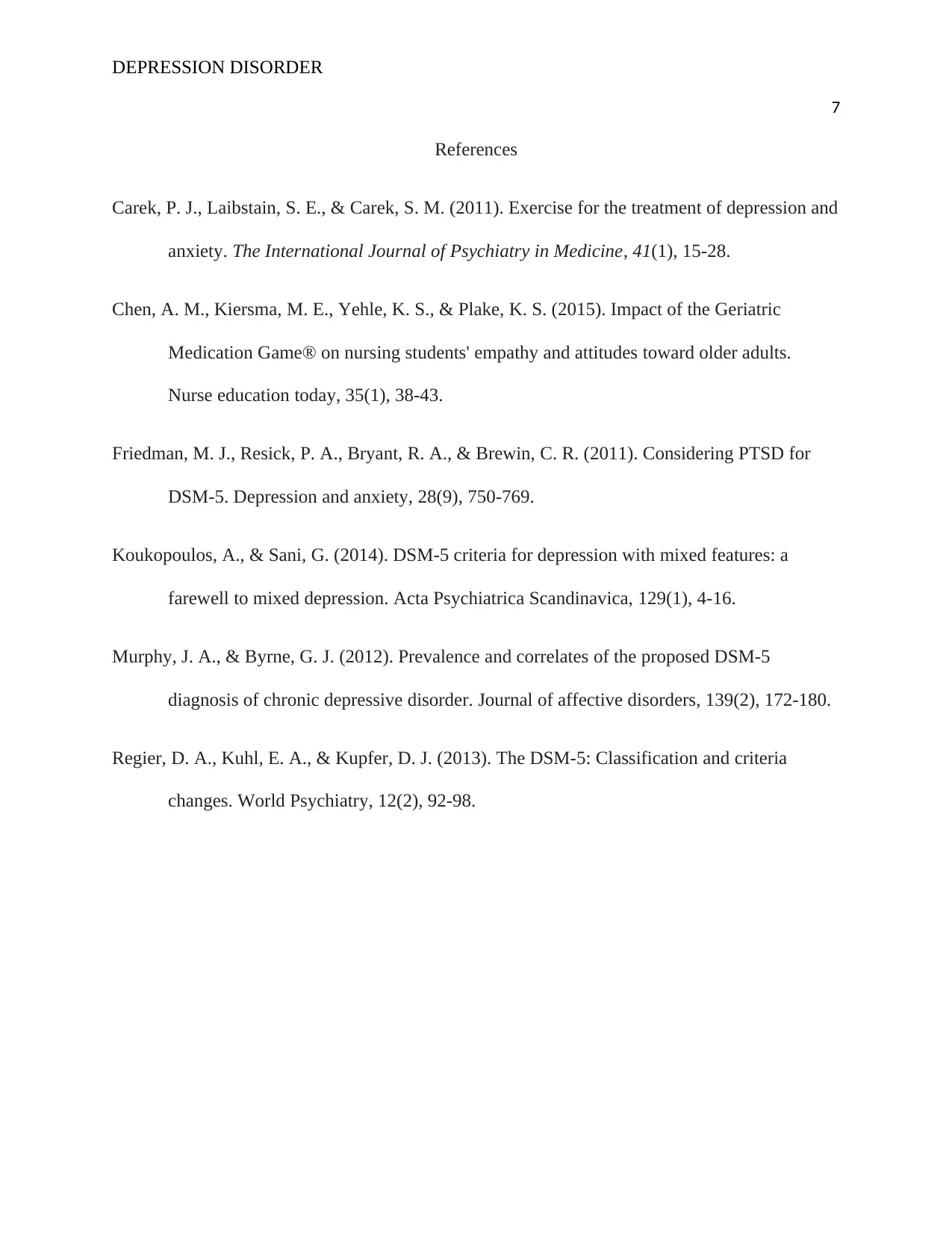
DEPRESSION DISORDER
7
References
Carek, P. J., Laibstain, S. E., & Carek, S. M. (2011). Exercise for the treatment of depression and
anxiety. The International Journal of Psychiatry in Medicine, 41(1), 15-28.
Chen, A. M., Kiersma, M. E., Yehle, K. S., & Plake, K. S. (2015). Impact of the Geriatric
Medication Game® on nursing students' empathy and attitudes toward older adults.
Nurse education today, 35(1), 38-43.
Friedman, M. J., Resick, P. A., Bryant, R. A., & Brewin, C. R. (2011). Considering PTSD for
DSM‐5. Depression and anxiety, 28(9), 750-769.
Koukopoulos, A., & Sani, G. (2014). DSM‐5 criteria for depression with mixed features: a
farewell to mixed depression. Acta Psychiatrica Scandinavica, 129(1), 4-16.
Murphy, J. A., & Byrne, G. J. (2012). Prevalence and correlates of the proposed DSM-5
diagnosis of chronic depressive disorder. Journal of affective disorders, 139(2), 172-180.
Regier, D. A., Kuhl, E. A., & Kupfer, D. J. (2013). The DSM‐5: Classification and criteria
changes. World Psychiatry, 12(2), 92-98.
7
References
Carek, P. J., Laibstain, S. E., & Carek, S. M. (2011). Exercise for the treatment of depression and
anxiety. The International Journal of Psychiatry in Medicine, 41(1), 15-28.
Chen, A. M., Kiersma, M. E., Yehle, K. S., & Plake, K. S. (2015). Impact of the Geriatric
Medication Game® on nursing students' empathy and attitudes toward older adults.
Nurse education today, 35(1), 38-43.
Friedman, M. J., Resick, P. A., Bryant, R. A., & Brewin, C. R. (2011). Considering PTSD for
DSM‐5. Depression and anxiety, 28(9), 750-769.
Koukopoulos, A., & Sani, G. (2014). DSM‐5 criteria for depression with mixed features: a
farewell to mixed depression. Acta Psychiatrica Scandinavica, 129(1), 4-16.
Murphy, J. A., & Byrne, G. J. (2012). Prevalence and correlates of the proposed DSM-5
diagnosis of chronic depressive disorder. Journal of affective disorders, 139(2), 172-180.
Regier, D. A., Kuhl, E. A., & Kupfer, D. J. (2013). The DSM‐5: Classification and criteria
changes. World Psychiatry, 12(2), 92-98.
1 out of 7
Related Documents
Your All-in-One AI-Powered Toolkit for Academic Success.
+13062052269
info@desklib.com
Available 24*7 on WhatsApp / Email
![[object Object]](/_next/static/media/star-bottom.7253800d.svg)
Unlock your academic potential
Copyright © 2020–2025 A2Z Services. All Rights Reserved. Developed and managed by ZUCOL.





